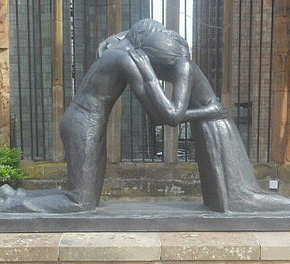 Reconciliation statue by Josefina de Vasconcellos, in St. Michael's Cathedral, Coventry, UKI recently came across an article by Paul Chambers in UK's Third Way Magazine, which provides a good introduction on restorative justice. Titled "Face-to-face justice," the piece begins by recounting a raw and emotionally powerful situation:
Reconciliation statue by Josefina de Vasconcellos, in St. Michael's Cathedral, Coventry, UKI recently came across an article by Paul Chambers in UK's Third Way Magazine, which provides a good introduction on restorative justice. Titled "Face-to-face justice," the piece begins by recounting a raw and emotionally powerful situation:
She walks down the long corridor from her cell to the meeting room, her fear and tension palpable. Never in my life have I seen someone so uncomfortable in her own skin. This young woman killed her father and now, nearly a decade later, is about to meet his brother - her uncle - for the first time since the death that irrevocably changed both their lives.
What does each hope to find in this meeting, with all its emotional risks? Perhaps some elusive answers to hard questions; but also a chance to tell their stories, to explain for the first time how deep the hurt has gone.
Sitting with them as their eyes met across the table, I silently will them to dig deep. Growth is rarely comfortable, and forgiveness can seem the most difficult of all human virtues to practice. And yet without it there is no reconciliation, either personal or collective - a belief I've reached not only through my Christian faith, but through my work in this growing field of restorative justice.
So what exactly is Restorative Justice? In simple terms it's about giving victims a voice. But more than that, RJ works to resolve conflict and repair harm. In practice, victim and perpetrator, often accompanied by family and friends, sit down with facilitators, who give the victim an opportunity to express their suffering and anger, and the perpetrator an opportunity to convey sincere remorse, and possible restitution for the harm. Harvard psychologist Steven Pinker, a passionate advocate, admits it sounds a little like daytime TV. And yet he argues persuasively that, contrary to popular belief, humankind has become progressively less violent through the ages - and that restorative justice has played a large part in this.
The article goes on to discuss the "ancient roots" of restorative justice, a brief history of RJ, including reference to Terry O'Connell's work in Wagga Wagga, New South Wales, Australia, a survey of research results, and a statement of hope that restorative justice may help resolve international conflicts.
The complete article may be found here.
